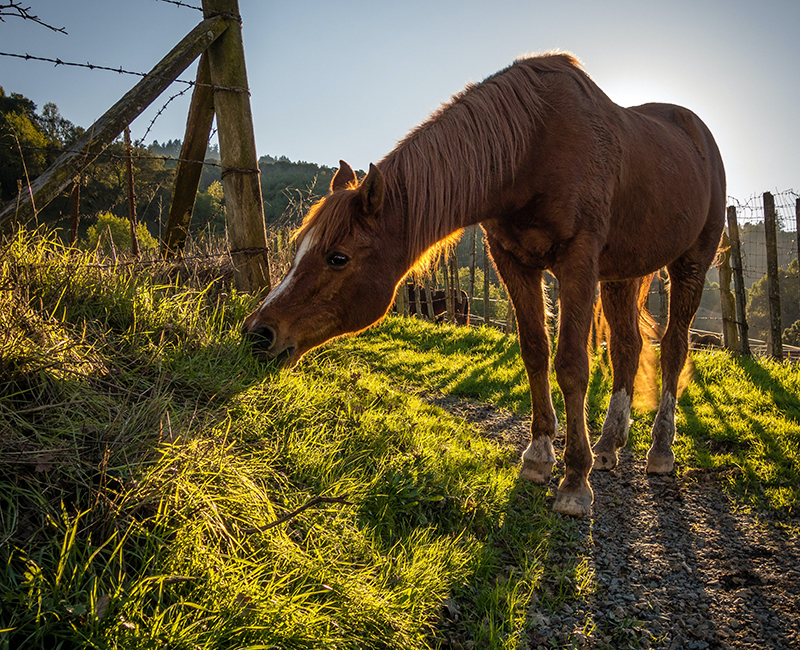Every year, once winter is over and the snow has receded, the grass starts its yearly explosion of growth. The spring helps bring hay and fresher forage for our horses. However, with the fresh forage comes the risk of a condition known as “grass founder.” This condition, a form of laminitis, can be lethal to horses with certain diseases, such as insulin resistance and Cushing’s disease.
Dr. Scott Austin, a boarded specialist in equine internal medicine at the University of Illinois Veterinary Teaching Hospital in Urbana, explains what causes this form of laminitis and how horse owners can protect their horses from getting it.
What Is Laminitis?
Laminitis is a very painful condition that involves sensitive structures, called the laminae, found in the hooves of horses. Lamina is a thin piece of tissue that attaches the coffin bone—the bone at the furthest extremity of the horse’s leg—to the inside of the hoof wall.
“The word laminitis literally means inflammation of the attachments between the hoof wall and skeleton,” explains Dr. Austin.
When damage to the laminae is severe, the coffin bone may sink or rotate within the hoof capsule—a condition called “founder”—resulting in severe and often debilitating pain.
Once rotation of the bone has occurred, the bone’s attachment to the hoof wall becomes permanently disrupted. A good farrier can help reduce the ill effects but cannot restore the original anatomy.
“It is much better to prevent laminitis than to manage the damage after the fact,” says Dr. Austin.
Laminitis can be triggered by many things, including grain overload, repeated striking of hard ground, hormonal imbalance (Cushing’s disease), obesity, and lastly lush grass.
Lush Forage
So what makes grass “lush” in the spring and how does it contribute to laminitis? The fertile grass of spring contains higher amounts of nonstructural carbohydrates, such as sugars and starches, and less structural carbohydrates or fiber, than grass later in the season.
Dr. Austin says, “As grass matures, there is a shift to structural carbohydrates making the grass more fibrous. When grass is starting to develop seed, we now this transformation has occured. When you squeeze some in your hand, you feel the stems poke you.”
In spring, when horses consume the lush grass, the extra starches and sugars ferment in the horses’ gastrointestinal tracts. This fermentation affects the balance of bacteria in the GI tract, which in turn can trigger laminitis.
The actual mechanism by which this change in the microbiome of the GI tract brings about laminitis hasn’t been identified. However, many researchers in equine nutrition are working to understand it.
Another problem related to spring grass arises in obese horses that have insulin resistance. “Exposure of an insulin-resistant horse to a high-carbohydrate diet, as we see with lush pastures, will cause a great increase in insulin levels in the horse,” says Dr. Austin. “High insulin levels can affect blood flow to the laminae and cause laminitis.”
Prevention
Although veterinarians are not exactly sure the mechanism that causes grass founder, there are many things owners can do to decrease the risk of laminitis in their horses.
“Don’t let your horse get fat,” warns Dr. Austin. “Learn how to recognize ideal body weight by doing body condition scoring. Obese horses should be tested for insulin resistance, and horses that are insulin resistant should not be allowed to graze on lush pastures.”
Instead, he advises keeping these horses in dry lot and feeding hay until pastures are more mature. Additionally, when these horses go out on pasture, use a grazing muzzle to decrease grass consumption.
“If the horse shows any tenderness when walking or turning, immediately remove it from pasture and have it evaluated by a veterinarian,” says Dr. Austin. “ Horses with previous episodes of laminitis should not be out on pasture or should only go out to mature pasture after consuming their morning hay ration and should wear a muzzle. Pastures should be mowed to keep grass short.”
Laminitis is a very painful condition that can be deadly. By learning about risk factors such as spring grass, horse owners can decrease the risk that their horses will founder.
By Reilee Juhl
Photo by Rich Dahlgren on Unsplash




